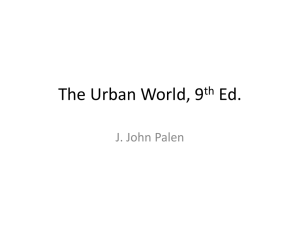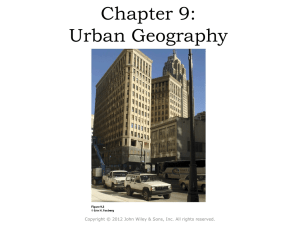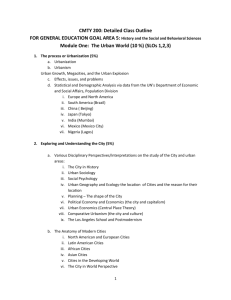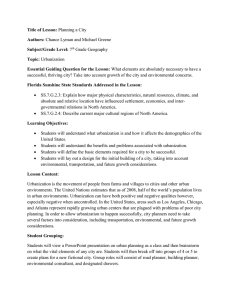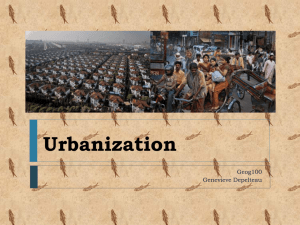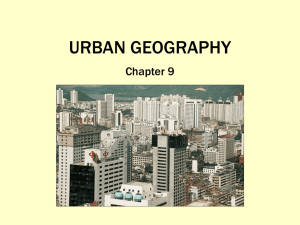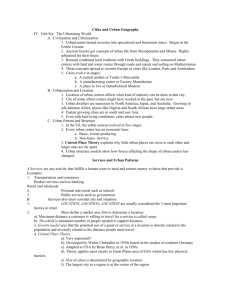chapter 21: civilization and urbanization
advertisement
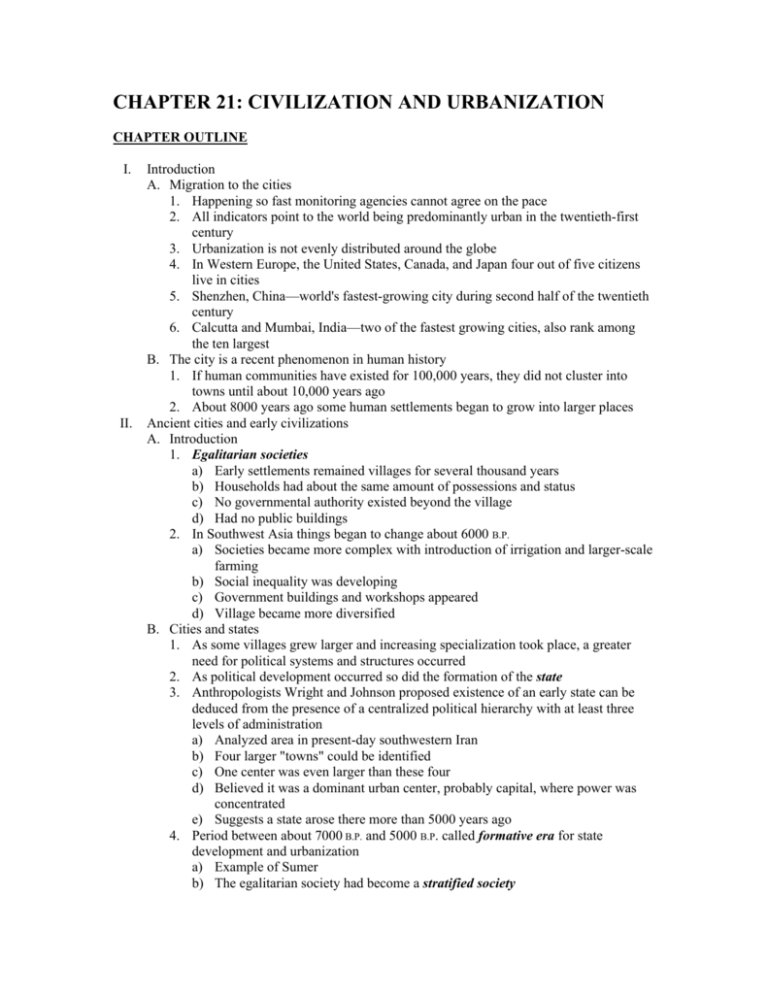
CHAPTER 21: CIVILIZATION AND URBANIZATION CHAPTER OUTLINE I. II. Introduction A. Migration to the cities 1. Happening so fast monitoring agencies cannot agree on the pace 2. All indicators point to the world being predominantly urban in the twentieth-first century 3. Urbanization is not evenly distributed around the globe 4. In Western Europe, the United States, Canada, and Japan four out of five citizens live in cities 5. Shenzhen, China—world's fastest-growing city during second half of the twentieth century 6. Calcutta and Mumbai, India—two of the fastest growing cities, also rank among the ten largest B. The city is a recent phenomenon in human history 1. If human communities have existed for 100,000 years, they did not cluster into towns until about 10,000 years ago 2. About 8000 years ago some human settlements began to grow into larger places Ancient cities and early civilizations A. Introduction 1. Egalitarian societies a) Early settlements remained villages for several thousand years b) Households had about the same amount of possessions and status c) No governmental authority existed beyond the village d) Had no public buildings 2. In Southwest Asia things began to change about 6000 B.P. a) Societies became more complex with introduction of irrigation and larger-scale farming b) Social inequality was developing c) Government buildings and workshops appeared d) Village became more diversified B. Cities and states 1. As some villages grew larger and increasing specialization took place, a greater need for political systems and structures occurred 2. As political development occurred so did the formation of the state 3. Anthropologists Wright and Johnson proposed existence of an early state can be deduced from the presence of a centralized political hierarchy with at least three levels of administration a) Analyzed area in present-day southwestern Iran b) Four larger "towns" could be identified c) One center was even larger than these four d) Believed it was a dominant urban center, probably capital, where power was concentrated e) Suggests a state arose there more than 5000 years ago 4. Period between about 7000 B.P. and 5000 B.P. called formative era for state development and urbanization a) Example of Sumer b) The egalitarian society had become a stratified society C. Function and location 1. Importance of geographic location a) Proximity to productive farmlands b) Irrigation invented c) Defense using fortified walls d) Towns in Mesopotamia enjoyed secure food supplies (Figure 3-2) e) In the Indus Basin cities were served by stone-lined wells (Figure 21-1) f) Closeness to trade routes 2. Urban elite—group of decision makers and organizers a) Urban elite could enjoy leisure time b) Devoted time to religion and philosophy c) Concept of writing and record-keeping 3. Mesopotamian cities a) Rulers in cities were both priests and kings b) City was usually protected by an earthen wall c) Temples built on artificial mounds dominated the urban landscape d) Lacked waste-disposal or sewage facilities 4. Many cities were theocratic centers where rulers were deemed to have divine authority (Figure 21-2) 5. Urbanization did not occur simultaneously in all culture hearths (Figure 21-3) 6. By modern standards early cities were not large a) Maybe between 10,000 and 15,000 people b) Size was determined by existing systems of food gathering and distribution and social organization III. Diffusion to Greece A. Urbanization spread from Mesopotamia in several directions 1. During the third millennium B.P. Greece became one of the most highly urbanized areas on Earth a) More than 500 cities and towns b) Athens had an estimated 250,000 inhabitants 2. In China, South Asia, and Mesoamerica an urban tradition was developing at the same time 3. Development in Greece had a global impact a) Inherited Southwest Asia innovations b) Transmitted its own urban traditions to the Roman Empire 4. Description of Greek cities IV. The Roman urban system A. The largest developed on Earth at that time (Figure 21-4) 1. A transport network linked places by road, sea, and river 2. Incorporated Etruscan's traditions 3. Used Greek rectangular grid pattern to layout cities wherever possible 4. Roman cities, just as the cities of today, showed great contrast from monumental buildings to the tenements housing the poor and slaves B. Post-Roman decline 1. Collapse of Roman Empire accompanied by disintegration of its urban system and decay of many cities 2. Many causes of empire's failure 3. Invasion by the Moors C. Urban growth elsewhere 1. Xian, China known as the Rome of East Asia 2. Trading cities developed along the southern margin of the Sahara 3. Mayan urbanization proceeded 4. Aztec capital of Teotihuacán may have had more than 100,000 people V. Post-Roman, pre-industrial Europe A. Medieval Europe 1. Muslim invasion galvanized Europeans into action 2. Crusades began 3. Influence of the so-called Medieval Optimum 4. Cities started to grow as commerce picked up 5. Cities were small by today’s standards B. Urban environments 1. With more efficient weapons and invention of gunpowder, walls and moats could no longer withstand armies 2. Better fortified cities built upward with the need to house more people 3. Effects of the Little Ice Age 4. By the seventeenth century, cities were generally slum-ridden, unsanitary, and depressing 5. When chance came many people left for America, Australia, and other parts of the world C. Models of urban places 1. Gideon Sjoberg a) Cities should be viewed as products of their societies b) Argued city levels could be divided into four categories (1) Folk-preliterate (2) Feudal (3) Preindustrial (4) Urban-industrial 2. A European city during feudal times was little more than a village 3. Cities grew during the consolidation of political power and the expansion of states 4. The dominant aspect of the pre-industrial city was the imposing complex of religious and governmental structures at its heart D. Primate cities 1. Sjoberg recognized emergence of the primate city 2. Not large but dominant, their influence underscored by the cluster of religious or governmental buildings at their center, spaciousness, and wealth 3. Generalizations about pre-industrial cities are always open to debate a) Not all cities were structured as Sjoberg suggested b) Examples: Muslim cities, city centers in Middle America, black African cities 4. Another viewpoint holds that the term "preindustrial" represents an inaccuracy E. The global spread of urbanization 1. Oases and resting places along the Silk Route grew into towns and some into cities 2. Chinese styles of city-building diffused into Korea and Japan 3. Urban banana—a crescent-shaped zone of early urbanization extending across Eurasia from England to Japan 4. Effects of European maritime exploration and overseas colonization a) Ushered in an era of oceanic trade b) Coastal cities gained prominence 5. The mercantile city of the colonial era brought revival and sometimes prosperity a) A central square became what we today call “downtown” b) Became nodes of a global network of regional, national, and international commerce 6. 7. 8. 9. 10. 11. 12. 13. 14. 15. 16. 17. c) Powerful trading companies and wealthy merchants established settlements in distant lands d) Was engulfed by desperate immigrants during the worst years of the “Little Ice Age” Emergence of the manufacturing city a) Emerged in British Midlands and spreading to Western Europe b) Cities became unregulated jumbles of activity c) Elegant housing was converted into overcrowded slums d) Sanitation systems failed e) Water supplies were inadequate and often polluted f) Children worked 12-hour shifts in textile mills Improvements were made by government intervention and city planning Many manufacturing cities in the New World never suffered as much as European cities During the second half of the twentieth century manufacturing cities stopped growing Today the global urban scene is undergoing another major transition Cities in the developing world have been growing at unprecedented rates Effect of transportation innovations a) Dispersal of urban population creating suburbanization b) The modern city Some geographers see what is often referred to as postmodernism in cities of technologically advanced societies Resulted in the modernization of the American manufacturing city The electric trolley and the automobile Factory workers from the suburbs could shop in the city center The modern city has not stabilized

